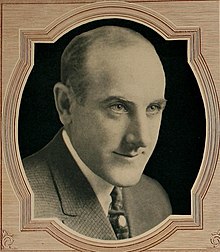Al Christie
This article includes a list of general references, but it lacks sufficient corresponding inline citations. (February 2013) |
Al Christie | |
|---|---|
 Christie in a 1920 Robertson-Cole ad | |
| Born | Alfred Ernest Christie 23 October 1881 London, Ontario, Canada |
| Died | April 14, 1951 (aged 69) Hollywood, California, U.S. |
| Other names | Al E. Christie Albert E. Christie Alfred E. Christie Al E. |
| Occupation(s) | Film director, producer, screenwriter |
| Years active | 1912–1941 |
| Spouse | Nora Leadbitter |
| Relatives | Charles Christie(brother) |
Alfred Ernest Christie (23 October 1881 – 14 April 1951) was a Canadian-born film director, producer, and screenwriter.
Biography
Alfred Ernest Christie was born in London, Ontario, Canada. One of a number of Canadian pioneers in early Hollywood, he began his career in 1909 working for David Horsley's Centaur Film Company in Bayonne, New Jersey.[1]: 77
In 1910, Christie began turning out a single-reel Mutt and Jeff comedy every week. The following year, Christie moved to Southern California to manage Centaur's West Coast unit, the Nestor Film Company. Nestor established the first permanent movie studio in Hollywood, opening on 27 October 1911.[2] Christie then created a partnership with his brother Charles to form Christie Film Company.
Christie Comedies, as they were known, were different from the fast-paced slapstick efforts of other producers. They relied more on humorous situations and embarrassing moments, and the action was slower and subtler. Christie's stars of the 1920s were former Mack Sennett juvenile Bobby Vernon, Neal Burns, Jimmie Adams, Walter Hiers, and sailor-suited comic Billy Dooley.
In the late 1920s, Christie also produced some of the first "talkie" films made with African American casts. The films starred Spencer Williams, Roberta Hyson, and Evelyn Preer as well as popular musical acts. Several of the films survive.[3]
Christie's own studio lasted until 1933 when the company went into receivership. Christie was then hired by Earle Hammons of Educational Pictures as a director, where he worked with The Ritz Brothers, Bob Hope, and Buster Keaton. Christie's last film was Half a Sinner (1940), originally produced by Hammons for Grand National Pictures and ultimately released by Universal Pictures.
Christie died in 1951. He has a star on the Hollywood Walk of Fame at 6771 Hollywood Boulevard.
See also
Selected filmography


- When the Heart Calls (1912)
- Almost a Rescue (1913)
- Some Runner (1913)
- An Elephant on His Hands (1913)
- When Lizzie Got Her Polish (1914)
- When Bess Got in Wrong (1914)
- Wanted: A Leading Lady (1915)
- Their Quiet Honeymoon (1915)
- Where the Heather Blooms (1915)
- Love and a Savage (1915)
- Some Chaperone (1915)
- Jed's Trip to the Fair (1916)
- Mingling Spirits (1916)
- All Dressed Up (1918)
- Know Thy Wife (1918)
- A Roman Scandal (1919)
- Her Bridal Nightmare (1920)
- So Long Letty (1920)
- Reckless Romance (1924)
- Hold Your Breath (1924)
- Seven Days (1925)
- The Melancholy Dame (1929)
- A Bird in the Hand (1929)
- Post Mortems (1929)
- Music Hath Harms (1929)
- Meet the Missus (1929)[4]
- Jed’s Vacation (1929)
- The Framing of the Shrew (1929)
- When Caesar Ran a Newspaper (1929)
- Hot Lemonade (1929)
- Oft in the Silly Night (1929)
- Dear Vivien (1929)
- Her Husband's Women (1929)
- A Hint to Brides (1929)
- Charley's Aunt (1930)
- Sweethearts on Parade (1930)
- Meet the Wife (1931)
- That Rascal (1932)
- Going Spanish (1934)
- The Chemist (1936)
- The Birth of a Baby (1938)
- Half a Sinner (1940)
References
- ^ Jacobs, Christopher P.; McCaffrey, Donald W. (1999). Guide to the Silent Years of American Cinema. Westport, Connecticut: Greenwood Press. ISBN 9780313303456.
- ^ Staff. "Memorial at First Studio Site Will Be Unveiled Today", Los Angeles Times, September 29, 1940. Accessed July 8, 2014.
- ^ Tribune, Donald Liebenson Special to the. "FOLK ART OR RACIAL STEREOTYPES?". chicagotribune.com.
- ^ http://libcat.calacademy.org/title/film-stills-scrapbook-meet-the-missus/oclc/969903355
External links
- Works by or about Al Christie at the Internet Archive
- Al Christie at IMDb
- List of films made by Christie Film Company at IMDB
- "Al Christie". Find a Grave. Retrieved 3 September 2010.
- Al. E. Christie, The Elements of Situation Comedy, "One of a series of lectures especially prepared for student-members of the Palmer Plan [of Photoplay Writing]." Published 1920.
- 1881 births
- 1951 deaths
- Film directors from London, Ontario
- Canadian film producers
- American male screenwriters
- Writers from London, Ontario
- American film studio executives
- Silent film producers
- Silent film directors
- Canadian film executives
- Burials at Hollywood Forever Cemetery
- 20th-century American male writers
- 20th-century American screenwriters
